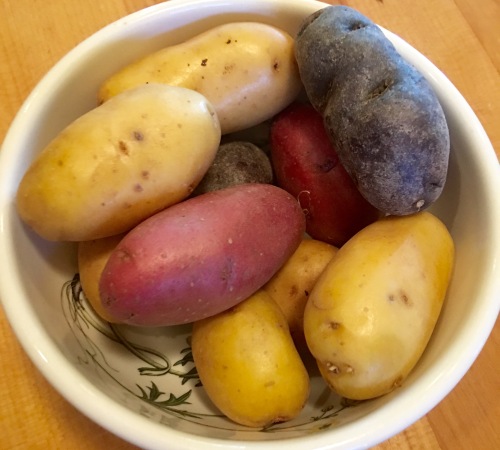I ate a lot of Swiss steak while growing up. I suspect a lot of kids of the 1950s and 1960s ate a lot of Swiss steak. It was fairly easy and fairly cheap. Moms could whip it together when they got home from work. It probably got even more popular when crock pots came along. Honestly, I didn’t much like it – too many vegetables. I’m over that dietary hang-up now.
I haven’t had Swiss steak for years, and I think it has fallen out of favor across the USA. I’m not sure why that might be. Perhaps it reflects the move away from red meat. Perhaps folks have come to prefer vegetables that haven’t been cooked to death. Whatever the reason, I am of the mind that it needs to be reinstated as a delicious family meal. If you add some potatoes – in this case, fingerlings from the farmers’ market – you wind up with a complete one-dish evening meal.

Fingerling potatoes
An interesting factoid that I learned in reading about Swiss steak: I had always assumed that Heidi’s mother made the dish while Heidi was out with the cows in a beautiful Alpine valley. Not so. “Swiss” refers to the process of pounding floured meat to tenderize it rather than to the country of origin. As to the pounding, the purpose is to break down muscle fibers in tougher cuts of meat. The simplest way to manage this step is to have your butcher run the meat through a “tenderizer” or “cuber”. In my opinion, while the process does indeed tenderize the meat, it brings it just one small step away from ground beef. A meat pounder, with or without teeth, is a useful home kitchen tool. The edge of a saucer or small plate works just as well.

A pounder is a useful kitchen tool

The geometry of pounded steak
RECIPE
Swiss Steak and Fingerling Potatoes

Halfway through the braising
Ingredients
- 1 cup all-purpose flour
- 2 tablespoons kosher salt
- 1 tablespoon ground black pepper
- 1 pound round steak, cut about 1 inch thick
- 3 tablespoons vegetable oil
- 1 large onion, sliced thinly
- 2 cloves garlic, minced
- 1 large carrot, peeled and sliced into ¼ inch discs
- 1 stalk celery, sliced thinly
- 1 large green bell pepper, seeded and sliced in rounds
- 8 medium crimini mushrooms, sliced
- 14.5 ounce can diced tomatoes
- ½ cup red wine
- ½ cup beef stock
- 2 teaspoons paprika
- 1 tablespoon tomato paste
- good pinch of sugar
- 2 bay leaves
- 8 – 12 fingerling potatoes
- salt and pepper to taste
Method
- In a pie plate or deep dish, combine the flour, salt, and pepper. Cut the round steak into serving-sized pieces and blot dry. Dredge the pieces of steak in the flour mixture, shake off any excess, and place one-by-one on a flat surface. Pound on each side, dredge again in flour, and pound on each side again.
- Over medium-high flame, heat the vegetable oil until it is shimmering. Add pieces of floured steak and brown on both sides, turning several times as the meat browns. Transfer the browned steaks to a plate.
- Add the onions to the oil remaining in the pan and stir until the onions are caramelized, about 5 minutes.
- Stir in the garlic, carrot, celery, bell pepper, and mushrooms. Sauté for about 5 minutes until the vegetables are lightly cooked and the celery is translucent.
- Stir in the canned tomatoes, wine, beef stock, paprika, tomato paste, and sugar. Add the bay leaves. Bring to the boil, cover, and transfer to the middle of an oven preheated to 225°F.
- Cook for at least 3 hours, stirring from time to time and adding more water if needed.
- About an hour and a half before you are ready to serve, add the fingerling potatoes, making sure they are well covered in the cooking liquid. Adjust the seasoning with salt and pepper. Remove the bay leaves.
- Serve the steak and potatoes in soup bowls, topped with the vegetables and sauce. Serves 3 – 4 persons.

Ready to eat

A hearty one pan meal 🙂
Thanks for your comment, Nandini. It is, indeed.
I certainly like Swiss steak, and yes have been known to cook it in my pressure cooker too! I usually serve mine over rice but I like the fingerling potatoes with it, yum!
I love the thought of pressure cooker Swiss steak. That would really work at high altitude.
It does work great at high altitude. I may not be as high as you are (3,700 feet) but have always needed to adjust for it for pasta, potatoes, cakes and the like.
This looks very nice, I will try it and put it on my menu for Fall!
Let me know if it works for you!